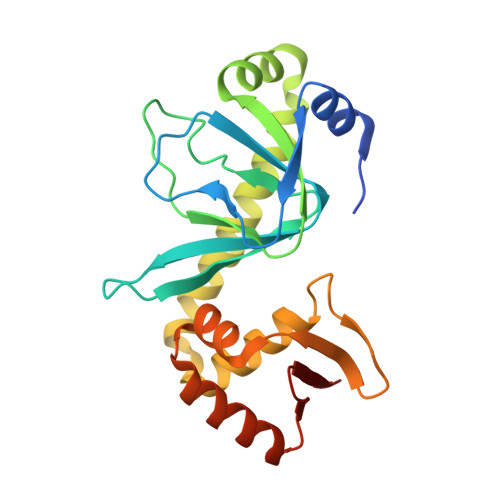The Cyclic AMP Receptor Protein Regulates Quorum Sensing and Global Gene Expression in Yersinia pestis during Planktonic Growth and Growth in Biofilms.
Ritzert, J.T., Minasov, G., Embry, R., Schipma, M.J., Satchell, K.J.F.(2019) mBio 10
- PubMed: 31744922
- DOI: https://doi.org/10.1128/mBio.02613-19
- Primary Citation of Related Structures:
6DT4 - PubMed Abstract:
Cyclic AMP (cAMP) receptor protein (Crp) is an important transcriptional regulator of Yersinia pestis Expression of crp increases during pneumonic plague as the pathogen depletes glucose and forms large biofilms within lungs. To better understand control of Y. pestis Crp, we determined a 1.8-Å crystal structure of the protein-cAMP complex. We found that compared to Escherichia coli Crp, C helix amino acid substitutions in Y. pestis Crp did not impact the cAMP dependency of Crp to bind DNA promoters. To investigate Y. pestis Crp-regulated genes during plague pneumonia, we performed RNA sequencing on both wild-type and Δ crp mutant bacteria growing in planktonic and biofilm states in minimal media with glucose or glycerol. Y. pestis Crp was found to dramatically alter expression of hundreds of genes in a manner dependent upon carbon source and growth state. Gel shift assays confirmed direct regulation of the malT and ptsG promoters, and Crp was then linked to Y. pestis growth on maltose as a sole carbon source. Iron regulation genes ybtA and fyuA were found to be indirectly regulated by Crp. A new connection between carbon source and quorum sensing was revealed as Crp was found to regulate production of acyl-homoserine lactones (AHLs) through direct and indirect regulation of genes for AHL synthetases and receptors. AHLs were subsequently identified in the lungs of Y. pestis -infected mice when crp expression was highest in Y. pestis biofilms. Thus, in addition to the well-studied pla gene, other Crp-regulated genes likely have important functions during plague infection. IMPORTANCE Bacterial pathogens have evolved extensive signaling pathways to translate environmental signals into changes in gene expression. While Crp has long been appreciated for its role in regulating metabolism of carbon sources in many bacterial species, transcriptional profiling has revealed that this protein regulates many other aspects of bacterial physiology. The plague pathogen Y. pestis requires this global regulator to survive in blood, skin, and lungs. During disease progression, this organism adapts to changes within these niches. In addition to regulating genes for metabolism of nonglucose sugars, we found that Crp regulates genes for virulence, metal acquisition, and quorum sensing by direct or indirect mechanisms. Thus, this single transcriptional regulator, which responds to changes in available carbon sources, can regulate multiple critical behaviors for causing disease.
Organizational Affiliation:
Department of Microbiology-Immunology, Northwestern University Feinberg School of Medicine, Chicago, Illinois, USA.
















